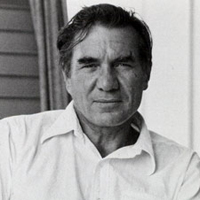First Song by Galway Kinnell: Summary and Critical Analysis
First Song is a typical Kinnell poem in which he tells the story (one incident) of a small boy who finds solace in the music of the frogs croaking in the evening at the city’s edge after a day’s straining labor. The frogs cacophonous croaking, which can be irritating to common people, here becomes a thing that brings the boy to an understanding of his own pathetic plight in the society that oppresses him, to the awareness of initiation into the adult world, to his energies and need for transcending the bondage of his life.

Galway Kinnell (1927-2014)
Besides, this transcendence of feelings and experience also represents his spiritual and almost mythic transcendence; that thread of the poem’s theme opens up the allegorical meaning of the fertility myths of the birth of Osiris in the spring. It is spring and the boy is being born to his adulthood, in the nature, and to understand as well as spiritual enlightenment. This boy comes to the city’s edge and begins to listen to the frogs’ song. And he is soon joined by a number of such other boys; the gathering can be seen as sprouting of the fertility gods from the nature, for the poet has suggested that through the description of the gathering.
Joined by two neighbors, the boy accompanies the frogs’ song with a primitive homemade instrument. The music they make, accompanying these natural creatures, becomes for the bay his first intimation of the connectedness of the human and the natural world, a theme Kinnell continues to explore in all his poems. This awakening, presented simply and directly, initiates the youth into the ambiguity that, for Kinnell, characterizes the human condition. The darkness becomes symbolic of our being surrounded by death, and the joy the youth learns depends in its opposite, sadness.
A boy is portrayed as tired of the day’s work of collecting dung hung onto the rail fence. Though the speaker does not specify who he is, we guess him to a Negro since the setting in an American city, Illinois where blacks were discriminated. The poet uses a strong metaphor ‘a sapped thing’ to mean the boy as if he were a plant without sap. In other words a dry, sterile, fatigued, charm-less thing not even a human. It gives a pitiable picture of a troubled boy who is too tired to cry.
Implied picture of the skyscrapers shows the juxtaposition of city houses and the boy’s hut perhaps at the outskirt. The boy’s familiarity is with small ponds. Pitfalls where dwell frogs busy singing joyfully and arresting his attention. The situation supplements the downtrodden life of possible black boys/child workers who have a very close relation to the nature. The poet as a narrator witnesses another boy being delighted by the sounds from the pond.
The poem is rich not only in its rhythmic and rhyming uniformity but also in its reference to domestic musical instruments used by the little boys who are indulging in the music they produce themselves; these are cornstalk violins. This image provokes the reader’s emotion to add sympathy with the poor, rustic, shabby boys yet submerged in their own pleasure as the stanza proceeds with ‘the three sat there scraping of their joy.’ The world scraping is rich to incorporate even the minutest shade of the meaning, which is, consuming gently and steadily every moment so that they will not leave any possible joy. The boys and the frogs have become one, both of them excitedly sing amidst the towering Illinois twilight- the phrase gives grandeur of the city. ‘Twilight’ can be a symbol of the children’s state of two emotions: pain and joy created by their social, economic position and the music respectively. Their hard, laborious, painful life is signified by the darkness and their happiness represented by daylight so both merges into twilight. This state of mixed emotion pushes them into darkness which indicates their severe miserable life. One of them despite his hunchback and aching shoulder is equally participating in the song and music which the poet (speaker) thinks to be the first song of his happiness. The last line of the third stanza is a dramatic irony, for the reader is supposed to understand the sadness which the boy is not aware of in his ecstatic melody. The reader is aware of the fact that the song is a waking of their heart in the darkness. This projects a pathetic atmosphere in the whole poem as we see the sadness being indistinguishably imbedded in their joy. It even makes us believe that it was not a joy but an outcome of suffering and interior pathos and misery.
Cite this Page!
Shrestha, Roma. "First Song by Galway Kinnell: Summary and Critical Analysis." BachelorandMaster, 9 Nov. 2013, bachelorandmaster.com/britishandamericanpoetry/first-song.html.
